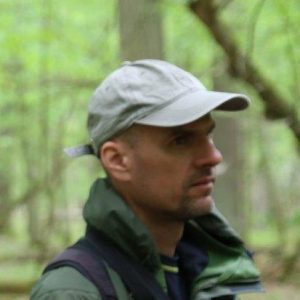2025
|
| Ayaz, Sajad Muhammad; Húdoková, Hana; Jamnická, Gabriela; Fleischer, Peter; Ditmarová, Ľubica; Razzak, Abdul; Ježík, Marek Relation between drought-exposed photosynthetic apparatus and tree water deficit derived from stem diameter variations in Norway spruce seedlings Journal Article Folia Oecologica, 52 (2), pp. 124–138, 2025, ISSN: 1338-7014. Links | BibTeX @article{Ayaz_2025,
title = {Relation between drought-exposed photosynthetic apparatus and tree water deficit derived from stem diameter variations in Norway spruce seedlings},
author = {Sajad Muhammad Ayaz and Hana Húdoková and Gabriela Jamnická and Peter Fleischer and Ľubica Ditmarová and Abdul Razzak and Marek Ježík},
url = {http://ife.sk/wp-content/uploads/2020/09/foecol-2025-0013.pdf},
doi = {10.2478/foecol-2025-0013},
issn = {1338-7014},
year = {2025},
date = {2025-07-01},
journal = {Folia Oecologica},
volume = {52},
number = {2},
pages = {124--138},
publisher = {Walter de Gruyter GmbH},
keywords = {},
pubstate = {published},
tppubtype = {article}
}
|
2023
|
 | HÚDOKOVÁ, H; JR, FLEISCHER P; JEŽÍK, M; MAREŠOVÁ, J; PŠIDOVÁ, E; MUKARRAM, M; DITMAROVÁ, Ľ; SLIACKA-KONÔPKOVÁ, A; JAMNICKÁ, G Can seedlings of Norway spruce (Picea abies L. H. Karst.) populations withstand changed climate conditions? Journal Article Photosynthetica, 61 (3), pp. 328–341, 2023, ISSN: 1573-9058. Links | BibTeX @article{H_DOKOV__2023,
title = {Can seedlings of Norway spruce (Picea abies L. H. Karst.) populations withstand changed climate conditions?},
author = {H HÚDOKOVÁ and P FLEISCHER JR and M JEŽÍK and J MAREŠOVÁ and E PŠIDOVÁ and M MUKARRAM and Ľ DITMAROVÁ and A SLIACKA-KONÔPKOVÁ and G JAMNICKÁ},
url = {http://dx.doi.org/10.32615/ps.2023.026},
doi = {10.32615/ps.2023.026},
issn = {1573-9058},
year = {2023},
date = {2023-10-01},
journal = {Photosynthetica},
volume = {61},
number = {3},
pages = {328–341},
publisher = {Institute of Experimental Botany},
keywords = {},
pubstate = {published},
tppubtype = {article}
}
|
2022
|
 | Salomón, Roberto L; Peters, Richard L; Zweifel, Roman; Sass-Klaassen, Ute G W; Stegehuis, Annemiek I; Smiljanic, Marko; Poyatos, Rafael; Babst, Flurin; Cienciala, Emil; Fonti, Patrick; Lerink, Bas J W; Lindner, Marcus; Martinez-Vilalta, Jordi; Mencuccini, Maurizio; Nabuurs, Gert-Jan; van der Maaten, Ernst; von Arx, Georg; Bär, Andreas; Akhmetzyanov, Linar; Balanzategui, Daniel; Bellan, Michal; Bendix, Jörg; Berveiller, Daniel; Blaženec, Miroslav; Čada, Vojtěch; Carraro, Vinicio; Cecchini, Sébastien; Chan, Tommy; Conedera, Marco; Delpierre, Nicolas; Delzon, Sylvain; Ditmarová, Ľubica; Dolezal, Jiri; Dufrêne, Eric; Edvardsson, Johannes; Ehekircher, Stefan; Forner, Alicia; Frouz, Jan; Ganthaler, Andrea; Gryc, Vladimír; Güney, Aylin; Heinrich, Ingo; Hentschel, Rainer; Janda, Pavel; Ježík, Marek; Kahle, Hans-Peter; Knüsel, Simon; Krejza, Jan; Kuberski, Łukasz; Kučera, Jiří; Lebourgeois, François; Mikoláš, Martin; Matula, Radim; Mayr, Stefan; Oberhuber, Walter; Obojes, Nikolaus; Osborne, Bruce; Paljakka, Teemu; Plichta, Roman; Rabbel, Inken; Rathgeber, Cyrille B K; Salmon, Yann; Saunders, Matthew; Scharnweber, Tobias; Sitková, Zuzana; Stangler, Dominik Florian; Stereńczak, Krzysztof; Stojanović, Marko; Střelcová, Katarína; Světlík, Jan; Svoboda, Miroslav; Tobin, Brian; Trotsiuk, Volodymyr; Urban, Josef; Valladares, Fernando; Vavrčík, Hanuš; Vejpustková, Monika; Walthert, Lorenz; Wilmking, Martin; Zin, Ewa; Zou, Junliang; Steppe, Kathy The 2018 European heatwave led to stem dehydration but not to consistent growth reductions in forests Journal Article Nature Communications, 13 (1), 2022, ISSN: 2041-1723. Links | BibTeX @article{Salom_n_2022,
title = {The 2018 European heatwave led to stem dehydration but not to consistent growth reductions in forests},
author = {Roberto L Salomón and Richard L Peters and Roman Zweifel and Ute G W Sass-Klaassen and Annemiek I Stegehuis and Marko Smiljanic and Rafael Poyatos and Flurin Babst and Emil Cienciala and Patrick Fonti and Bas J W Lerink and Marcus Lindner and Jordi Martinez-Vilalta and Maurizio Mencuccini and Gert-Jan Nabuurs and Ernst van der Maaten and Georg von Arx and Andreas Bär and Linar Akhmetzyanov and Daniel Balanzategui and Michal Bellan and Jörg Bendix and Daniel Berveiller and Miroslav Blaženec and Vojtěch Čada and Vinicio Carraro and Sébastien Cecchini and Tommy Chan and Marco Conedera and Nicolas Delpierre and Sylvain Delzon and Ľubica Ditmarová and Jiri Dolezal and Eric Dufrêne and Johannes Edvardsson and Stefan Ehekircher and Alicia Forner and Jan Frouz and Andrea Ganthaler and Vladimír Gryc and Aylin Güney and Ingo Heinrich and Rainer Hentschel and Pavel Janda and Marek Ježík and Hans-Peter Kahle and Simon Knüsel and Jan Krejza and Łukasz Kuberski and Jiří Kučera and François Lebourgeois and Martin Mikoláš and Radim Matula and Stefan Mayr and Walter Oberhuber and Nikolaus Obojes and Bruce Osborne and Teemu Paljakka and Roman Plichta and Inken Rabbel and Cyrille B K Rathgeber and Yann Salmon and Matthew Saunders and Tobias Scharnweber and Zuzana Sitková and Dominik Florian Stangler and Krzysztof Stereńczak and Marko Stojanović and Katarína Střelcová and Jan Světlík and Miroslav Svoboda and Brian Tobin and Volodymyr Trotsiuk and Josef Urban and Fernando Valladares and Hanuš Vavrčík and Monika Vejpustková and Lorenz Walthert and Martin Wilmking and Ewa Zin and Junliang Zou and Kathy Steppe},
url = {http://dx.doi.org/10.1038/s41467-021-27579-9},
doi = {10.1038/s41467-021-27579-9},
issn = {2041-1723},
year = {2022},
date = {2022-01-01},
journal = {Nature Communications},
volume = {13},
number = {1},
publisher = {Springer Science and Business Media LLC},
keywords = {},
pubstate = {published},
tppubtype = {article}
}
|
2021
|
 | Ježík, Marek; Blaženec, Miroslav; Mezei, Pavel; Sedmáková, Denisa; Sedmák, Róbert; Fleischer, Peter; Fleischer, Peter; Bošeľa, Michal; Kurjak, Daniel; Střelcová, Katarína; Ditmarová, Ľubica Influence of weather and day length on intra-seasonal growth of Norway spruce (Picea abies) and European beech (Fagus sylvatica) in a natural montane forest Journal Article Canadian Journal of Forest Research, 51 (12), pp. 1799–1810, 2021, ISSN: 1208-6037. Links | BibTeX @article{Je_k_2021,
title = {Influence of weather and day length on intra-seasonal growth of Norway spruce (Picea abies) and European beech (Fagus sylvatica) in a natural montane forest},
author = {Marek Ježík and Miroslav Blaženec and Pavel Mezei and Denisa Sedmáková and Róbert Sedmák and Peter Fleischer and Peter Fleischer and Michal Bošeľa and Daniel Kurjak and Katarína Střelcová and Ľubica Ditmarová},
url = {http://dx.doi.org/10.1139/cjfr-2020-0067},
doi = {10.1139/cjfr-2020-0067},
issn = {1208-6037},
year = {2021},
date = {2021-12-01},
journal = {Canadian Journal of Forest Research},
volume = {51},
number = {12},
pages = {1799–1810},
publisher = {Canadian Science Publishing},
keywords = {},
pubstate = {published},
tppubtype = {article}
}
|
2020
|
 | Jamnická, Gabriela; Konôpková, Alena; Fleischer, Peter; Kurjak, Daniel; Petrík, Peter; Petek, Anja; Húdoková, Hana; Fleischer, Peter; Homolová, Zuzana; Ježík, Marek; Ditmarová, Ľubica Physiological vitality of Norway spruce (Picea abies L.) stands along an altitudinal gradient in Tatra National Park Journal Article Central European Forestry Journal, 66 (4), pp. 227-242, 2020, ISBN: 2454-034X. Abstract | Links | BibTeX @article{Jamnická2020,
title = {Physiological vitality of Norway spruce (\textit{Picea abies} L.) stands along an altitudinal gradient in Tatra National Park},
author = {Gabriela Jamnická and Alena Konôpková and Peter Fleischer and Daniel Kurjak and Peter Petrík and Anja Petek and Hana Húdoková and Peter Fleischer and Zuzana Homolová and Marek Ježík and Ľubica Ditmarová},
doi = {10.2478/forj-2020-0019},
isbn = {2454-034X},
year = {2020},
date = {2020-12-02},
journal = {Central European Forestry Journal},
volume = {66},
number = {4},
pages = {227-242},
abstract = {Nowadays, a large area of Norway spruce forest stands in Europe is disturbed by windstorm and, subsequently, bark beetle outbreaks. We investigated the state of three disturbed spruce stands along an altitudinal gradient in Tatra National Park (Slovakia) through various physiological processes. Tree-growth characteristics, the mineral nutrition in the needles, and photosynthetic efficiency were assessed. Two techniques of chlorophyll a fluorescence and analyses of assimilatory pigments were used to detect the changes in photosynthesis functioning. Also, the heat sensitivity of photosystem II was tested. Our results showed that these stands are located in nutrient-poor environments. We recorded similar contents of nitrogen, phosphorus, potassium, sodium, zinc, and iron in all stands. Down the vertical transect, the contents of calcium, magnesium, and manganese significantly decreased and the non-essential aluminium increased. Based on stem circumference measurements, water deficit occurred during the vegetation season in all stands, but with the smallest magnitude highest U–stand. We found some photosynthetic constraints: slightly lower chlorophyll contents in all stands were recorded; however, seasonal dynamics with increasing chlorophyll concentration in the highest U–stand were observed. Moreover, the photochemistry of the lowest D–stand was the most negatively influenced by simulated heat, as the photosynthetic performance index, and the density of the active reactions centres significantly decreased and the values of the K–step and basal fluorescence increased. Therefore, we can conclude the different levels of physiological vitality in these naturally damaged spruce stands, with the best physiological performance of the trees in the highest stand.},
keywords = {},
pubstate = {published},
tppubtype = {article}
}
Nowadays, a large area of Norway spruce forest stands in Europe is disturbed by windstorm and, subsequently, bark beetle outbreaks. We investigated the state of three disturbed spruce stands along an altitudinal gradient in Tatra National Park (Slovakia) through various physiological processes. Tree-growth characteristics, the mineral nutrition in the needles, and photosynthetic efficiency were assessed. Two techniques of chlorophyll a fluorescence and analyses of assimilatory pigments were used to detect the changes in photosynthesis functioning. Also, the heat sensitivity of photosystem II was tested. Our results showed that these stands are located in nutrient-poor environments. We recorded similar contents of nitrogen, phosphorus, potassium, sodium, zinc, and iron in all stands. Down the vertical transect, the contents of calcium, magnesium, and manganese significantly decreased and the non-essential aluminium increased. Based on stem circumference measurements, water deficit occurred during the vegetation season in all stands, but with the smallest magnitude highest U–stand. We found some photosynthetic constraints: slightly lower chlorophyll contents in all stands were recorded; however, seasonal dynamics with increasing chlorophyll concentration in the highest U–stand were observed. Moreover, the photochemistry of the lowest D–stand was the most negatively influenced by simulated heat, as the photosynthetic performance index, and the density of the active reactions centres significantly decreased and the values of the K–step and basal fluorescence increased. Therefore, we can conclude the different levels of physiological vitality in these naturally damaged spruce stands, with the best physiological performance of the trees in the highest stand. |
 | Konôpková, Alena; Pšidová, Eva; Kurjak, Daniel; Stojnić, Srđan; Petrík, Peter; Jr, Peter Fleischer; Kučerová, Jana; Ježík, Marek; Petek, Anja; Gömöry, Dušan; Kmeť, Jaroslav; Longauer, Roman; Ditmarová, Ľubica Photosynthetic performance of silver fir (Abies alba) of different origins under suboptimal growing conditions Journal Article Functional Plant Biology, 47 (11), pp. 1007-1018, 2020, ISSN: 1445-4408. Abstract | Links | BibTeX @article{Konôpková2020c,
title = {Photosynthetic performance of silver fir (\textit{Abies alba}) of different origins under suboptimal growing conditions},
author = {Alena Konôpková and Eva Pšidová and Daniel Kurjak and Srđan Stojnić and Peter Petrík and Peter Fleischer Jr and Jana Kučerová and Marek Ježík and Anja Petek and Dušan Gömöry and Jaroslav Kmeť and Roman Longauer and Ľubica Ditmarová},
doi = {10.1071/FP20040},
issn = {1445-4408},
year = {2020},
date = {2020-06-24},
journal = {Functional Plant Biology},
volume = {47},
number = {11},
pages = {1007-1018},
abstract = {Understanding of the intraspecific variability in the physiological stress response of trees may enable to mitigate the impact of climate change on forest ecosystems in the future. We studied the photosynthetic performance of five silver fir (Abies alba Mill.) provenances originating from climatically distinct localities. The study was performed in the trial plot of the silver fir provenance experiment IUFRO 2005 on two dates: in the early summer and in the late summer. Heat waves and a decrease in water availability occurred between the two measurement dates, allowing us to study the response of the provenances to suboptimal growing conditions. The provenances were evaluated at the level of PSII photochemistry and CO2 assimilation by measuring photosynthesis-related pigment content, chlorophyll a fluorescence, and gas exchange parameters. Significant climatic clines were confirmed: the photosynthetic performance before and after the stress period increased with the increasing altitude and precipitation at the site of origin. In contrast, photosynthetic performance declined with the increasing temperature and Ellenberg’s quotient of the origin site. We concluded that provenances originating from high altitudes, corresponding well with more humid and colder conditions in Central Europe, showed the greatest photosynthetic performance and were less responsive to moderate heat and drought. This documents inter-population variation in physiological traits, which needs to be considered in setting rules and recommendations for the transfer of forest reproductive materials.},
keywords = {},
pubstate = {published},
tppubtype = {article}
}
Understanding of the intraspecific variability in the physiological stress response of trees may enable to mitigate the impact of climate change on forest ecosystems in the future. We studied the photosynthetic performance of five silver fir (Abies alba Mill.) provenances originating from climatically distinct localities. The study was performed in the trial plot of the silver fir provenance experiment IUFRO 2005 on two dates: in the early summer and in the late summer. Heat waves and a decrease in water availability occurred between the two measurement dates, allowing us to study the response of the provenances to suboptimal growing conditions. The provenances were evaluated at the level of PSII photochemistry and CO2 assimilation by measuring photosynthesis-related pigment content, chlorophyll a fluorescence, and gas exchange parameters. Significant climatic clines were confirmed: the photosynthetic performance before and after the stress period increased with the increasing altitude and precipitation at the site of origin. In contrast, photosynthetic performance declined with the increasing temperature and Ellenberg’s quotient of the origin site. We concluded that provenances originating from high altitudes, corresponding well with more humid and colder conditions in Central Europe, showed the greatest photosynthetic performance and were less responsive to moderate heat and drought. This documents inter-population variation in physiological traits, which needs to be considered in setting rules and recommendations for the transfer of forest reproductive materials. |
 | Konôpková, Alena; Húdoková, Hana; Ježík, Marek; Kurjak, Daniel; Jamnická, Gabriela; Ditmarová, Ľubica; Gömöry, Dušan; Longauer, R; Tognetti, Roberto; Pšidová, Eva Origin rather than mild drought stress influenced chlorophyll a fluorescence in contrasting silver fir (Abies alba Mill.) provenances Journal Article Photosynthetica : international journal for photosynthesis research, 58 , pp. 549-559, 2020, ISSN: 0300-3604. Abstract | Links | BibTeX @article{Konôpková2020b,
title = {Origin rather than mild drought stress influenced chlorophyll a fluorescence in contrasting silver fir (\textit{Abies alba Mill.}) provenances},
author = {Alena Konôpková and Hana Húdoková and Marek Ježík and Daniel Kurjak and Gabriela Jamnická and Ľubica Ditmarová and Dušan Gömöry and R. Longauer and Roberto Tognetti and Eva Pšidová},
doi = {10.32615/ps.2020.011},
issn = {0300-3604},
year = {2020},
date = {2020-01-01},
journal = {Photosynthetica : international journal for photosynthesis research},
volume = {58},
pages = {549-559},
abstract = {The performance of PSII photochemistry in five Central European provenances of silver fir differing in the altitude of origin (250-1,300 m a.s.l.) were studied using the chlorophyll a fluorescence parameters derived from the JIP-test. Measurements were performed on two dates in 2016: at the start and at the peak of growing season. Within this period, mild water stress was recorded, allowing us to monitor changes in photochemistry under drought conditions. Our results confirmed that silver fir is generally resistant to water deficit at the PSII level. However, the differences in photochemistry between provenances originating from different climatic conditions were observed. The high-altitude provenances (from wetter and colder localities) achieved higher PSII efficiency, which was also supported by clear trends along the climatic and geographic gradients of the provenance origins. After the drought, comparable PSII efficiency for low-altitude provenances and even higher for these originating in higher altitudes was observed.},
keywords = {},
pubstate = {published},
tppubtype = {article}
}
The performance of PSII photochemistry in five Central European provenances of silver fir differing in the altitude of origin (250-1,300 m a.s.l.) were studied using the chlorophyll a fluorescence parameters derived from the JIP-test. Measurements were performed on two dates in 2016: at the start and at the peak of growing season. Within this period, mild water stress was recorded, allowing us to monitor changes in photochemistry under drought conditions. Our results confirmed that silver fir is generally resistant to water deficit at the PSII level. However, the differences in photochemistry between provenances originating from different climatic conditions were observed. The high-altitude provenances (from wetter and colder localities) achieved higher PSII efficiency, which was also supported by clear trends along the climatic and geographic gradients of the provenance origins. After the drought, comparable PSII efficiency for low-altitude provenances and even higher for these originating in higher altitudes was observed. |
2019
|
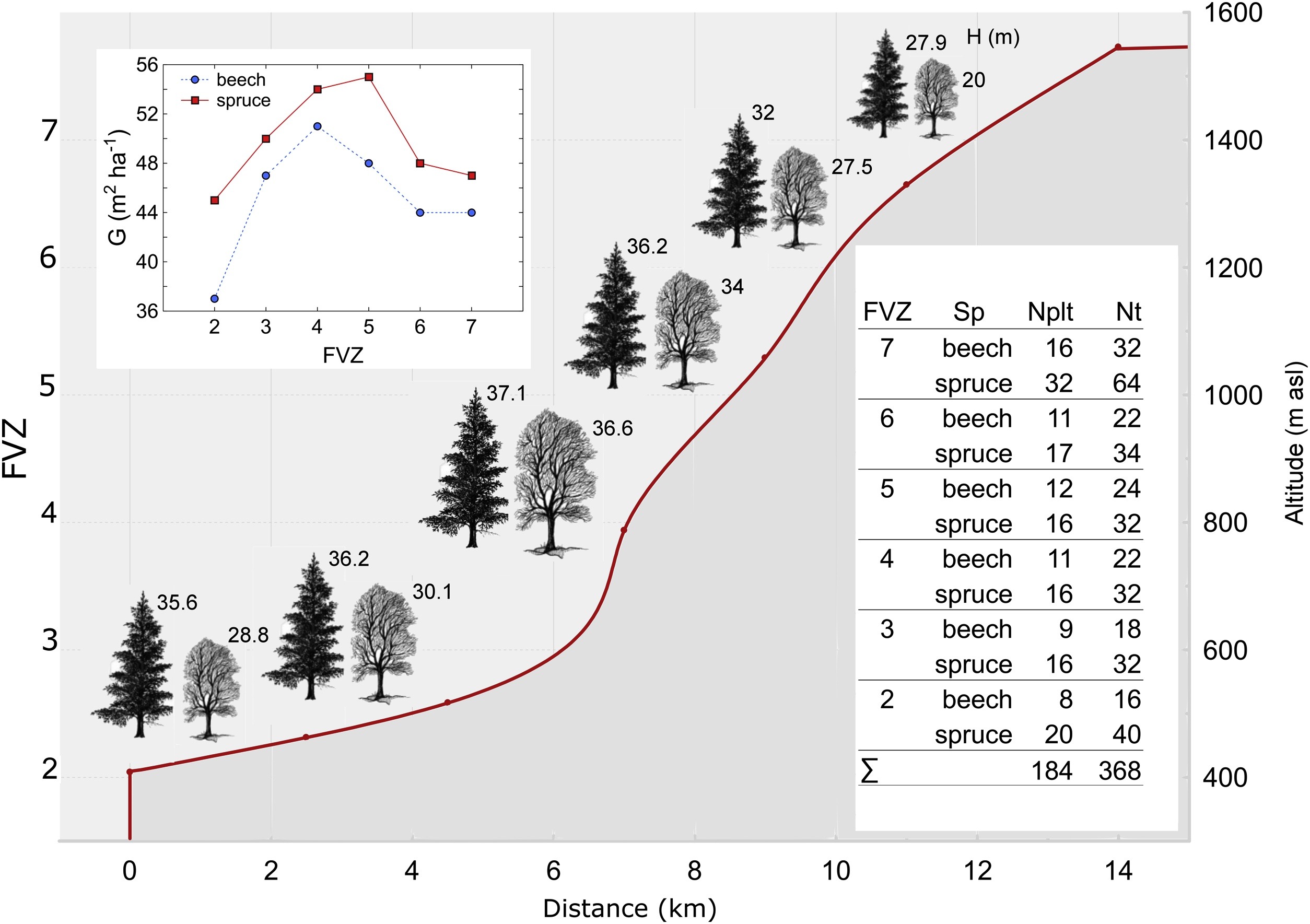 | Denisa Sedmáková Róbert Sedmák, Michal Bosela Marek Ježík Miroslav Blaženec Tomáš Hlásny Róbert Marušák Growth-climate responses indicate shifts in the competitive ability of European beech and Norway spruce under recent climate warming in East-Central Europe Journal Article Dendrochronologia, 54 , pp. 67-48, 2019, ISSN: 1125-7865. Abstract | Links | BibTeX @article{Sedmáková2019,
title = {Growth-climate responses indicate shifts in the competitive ability of European beech and Norway spruce under recent climate warming in East-Central Europe},
author = {Denisa Sedmáková, Róbert Sedmák, Michal Bosela, Marek Ježík, Miroslav Blaženec, Tomáš Hlásny, Róbert Marušák},
doi = {10.1016/j.dendro.2019.02.001},
issn = {1125-7865},
year = {2019},
date = {2019-04-01},
journal = {Dendrochronologia},
volume = {54},
pages = {67-48},
abstract = {Long-term changes in climate substantially affect the tree growth and species distribution in Europe. In the presented study, the radial growth of Fagus sylvatica (L.) and Picea abies ((L.) Karst.) has been studied along an altitudinal gradient covering six vegetation formations characteristic for sub-montane, montane and high-montane conditions of the western Carpathians. Tree growth responses to temperature and precipitation changes have been analysed based on the sample of increment cores and standard dendroclimatic methods in two time periods, the reference period 1961–1990 and the recent period 1991–2012. The growth responses of spruce and beech to recent changes in climate were similar up to high-montane zones, where the beech shows significantly larger improvements of radial increments in comparison to spruce. The growth responses were mainly temperature driven. In the sub-montane area, the increased effect of precipitation in the recent period was overridden by the negative effects of warming, and the alleviated temperature limitation had an evidently supportive effect on tree growth in montane and high-montane areas. In the near future, the warming will likely cause decline in radial increments of beech and spruce in sub-montane areas due to expected landscape drying. At the same time, the improved competitive ability of beech in the high-montane zones suggests a shift in the leading edge of beech distribution into higher altitudes in East-Central Europe.},
keywords = {},
pubstate = {published},
tppubtype = {article}
}
Long-term changes in climate substantially affect the tree growth and species distribution in Europe. In the presented study, the radial growth of Fagus sylvatica (L.) and Picea abies ((L.) Karst.) has been studied along an altitudinal gradient covering six vegetation formations characteristic for sub-montane, montane and high-montane conditions of the western Carpathians. Tree growth responses to temperature and precipitation changes have been analysed based on the sample of increment cores and standard dendroclimatic methods in two time periods, the reference period 1961–1990 and the recent period 1991–2012. The growth responses of spruce and beech to recent changes in climate were similar up to high-montane zones, where the beech shows significantly larger improvements of radial increments in comparison to spruce. The growth responses were mainly temperature driven. In the sub-montane area, the increased effect of precipitation in the recent period was overridden by the negative effects of warming, and the alleviated temperature limitation had an evidently supportive effect on tree growth in montane and high-montane areas. In the near future, the warming will likely cause decline in radial increments of beech and spruce in sub-montane areas due to expected landscape drying. At the same time, the improved competitive ability of beech in the high-montane zones suggests a shift in the leading edge of beech distribution into higher altitudes in East-Central Europe. |
2018
|
 | Nalevanková, Paulína; Ježík, Marek; Sitková, Zuzana; Vido, Jaroslav; Leštianska, Adriana; Střelcová, Katarína Drought and irrigation affect transpiration rate and morning tree water status of a mature European beech (Fagus sylvatica L.) forest in Central Europe Journal Article Ecohydrology, 11 (6), 2018, ISSN: 1936-0584. Abstract | Links | BibTeX @article{Nalevanková2018,
title = {Drought and irrigation affect transpiration rate and morning tree water status of a mature European beech (\textit{Fagus sylvatica} L.) forest in Central Europe},
author = {Paulína Nalevanková and Marek Ježík and Zuzana Sitková and Jaroslav Vido and Adriana Leštianska and Katarína Střelcová},
doi = {10.1002/eco.1958},
issn = {1936-0584},
year = {2018},
date = {2018-03-08},
journal = {Ecohydrology},
volume = {11},
number = {6},
abstract = {Severity and frequency of recurrent droughts is likely to be amplified by recent climate changes and may adversely affect large areas of temperate forests. This study addresses the ecophysiological responses of a mature beech forest in Central Europe (Slovakia, 450 m a.s.l.) exposed to drought during the growing seasons of 2012–2014. Sap flow and stem circumference changes of European beech (Fagus sylvatica L.) were measured in two contrasting treatments (drought vs. irrigation). Limited water availability reflected in the morning tree water status (morning stem contraction, ΔW) significantly reduced transpiration. Trees stressed by drought in the years 2012 and 2013 showed remarkably lower values of morning ΔW than those in the irrigated group. This suggests (a) lower water potential of the stem‐conducting tissues and (b) increased use of internally stored water to maintain daily transpiration. Additionally, morning ΔW showed a close relationship with soil water potential, particularly in the nonirrigated trees. Potential evapotranspiration (PET) explained less variability in the transpiration of the control stand than that of the irrigated stand. The use of a simple analysis of covariance model comprising morning ΔW and PET interaction significantly increased the explained variability in transpiration in the control stand. Morning ΔW of mature beech trees seems to be a useful and easily obtainable non‐invasive bioindicator of their ability to reduce and regulate transpiration in relation to atmospheric evaporative demands in response to drought.},
keywords = {},
pubstate = {published},
tppubtype = {article}
}
Severity and frequency of recurrent droughts is likely to be amplified by recent climate changes and may adversely affect large areas of temperate forests. This study addresses the ecophysiological responses of a mature beech forest in Central Europe (Slovakia, 450 m a.s.l.) exposed to drought during the growing seasons of 2012–2014. Sap flow and stem circumference changes of European beech (Fagus sylvatica L.) were measured in two contrasting treatments (drought vs. irrigation). Limited water availability reflected in the morning tree water status (morning stem contraction, ΔW) significantly reduced transpiration. Trees stressed by drought in the years 2012 and 2013 showed remarkably lower values of morning ΔW than those in the irrigated group. This suggests (a) lower water potential of the stem‐conducting tissues and (b) increased use of internally stored water to maintain daily transpiration. Additionally, morning ΔW showed a close relationship with soil water potential, particularly in the nonirrigated trees. Potential evapotranspiration (PET) explained less variability in the transpiration of the control stand than that of the irrigated stand. The use of a simple analysis of covariance model comprising morning ΔW and PET interaction significantly increased the explained variability in transpiration in the control stand. Morning ΔW of mature beech trees seems to be a useful and easily obtainable non‐invasive bioindicator of their ability to reduce and regulate transpiration in relation to atmospheric evaporative demands in response to drought. |
2016
|
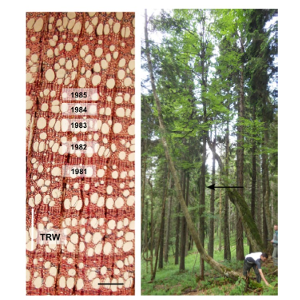 | Sedmáková, D; Sedmák, R; Bošela, M; Ježík, M; Sitko, R; Hlásny, T; Blaženec, M Cross-dating tree-ring series of living European beech by isochronic weather records Journal Article Geochronometria, 43 (1), pp. 48-58, 2016, ISSN: 1897-1695. Abstract | Links | BibTeX @article{Sedmáková2016,
title = {Cross-dating tree-ring series of living European beech by isochronic weather records},
author = {D. Sedmáková and R. Sedmák and M. Bošela and M. Ježík and R. Sitko and T. Hlásny and M. Blaženec},
url = {10.1515/geochr-2015-0030},
doi = {10.1515/geochr-2015-0030},
issn = {1897-1695},
year = {2016},
date = {2016-05-20},
journal = {Geochronometria},
volume = {43},
number = {1},
pages = {48-58},
abstract = {The main objective of the study is to facilitate cross-dating of sensitive tree-ring series from living European beech (Fagus sylvatica L.) trees in the absence of a regional chronology. The main idea lies in the preliminary dating of marker rings or ring patterns visually identified on the wood (before the ring-width measurements), which is independently validated through a moving correlation between a tentative reference chronology and instrumental climate records (after the ring-width measurements). Following the detection of low moving correlations, potentially misdated segments or series are re-examined and a new tentative reference chronology is constructed. The process is repeated as long as a higher correlation with climate is obtainable. The applicability of this method was investigated on three difficult-to-date sets of tree-ring series of beech trees which were growing at temperature-or precipitation-sensitive locations in under-canopy or canopy positions. A good ability of the combined method for the cross-dating was practiced on datasets almost impossible to cross-date by commonly used approaches. Highlighting the actual correlation of ring widths with climate in tree-ring series makes the cross-dating process more independent from human decisions, so the combined cross-dating has the potential to improve the reliability of various dendrochronological studies.},
keywords = {},
pubstate = {published},
tppubtype = {article}
}
The main objective of the study is to facilitate cross-dating of sensitive tree-ring series from living European beech (Fagus sylvatica L.) trees in the absence of a regional chronology. The main idea lies in the preliminary dating of marker rings or ring patterns visually identified on the wood (before the ring-width measurements), which is independently validated through a moving correlation between a tentative reference chronology and instrumental climate records (after the ring-width measurements). Following the detection of low moving correlations, potentially misdated segments or series are re-examined and a new tentative reference chronology is constructed. The process is repeated as long as a higher correlation with climate is obtainable. The applicability of this method was investigated on three difficult-to-date sets of tree-ring series of beech trees which were growing at temperature-or precipitation-sensitive locations in under-canopy or canopy positions. A good ability of the combined method for the cross-dating was practiced on datasets almost impossible to cross-date by commonly used approaches. Highlighting the actual correlation of ring widths with climate in tree-ring series makes the cross-dating process more independent from human decisions, so the combined cross-dating has the potential to improve the reliability of various dendrochronological studies. |
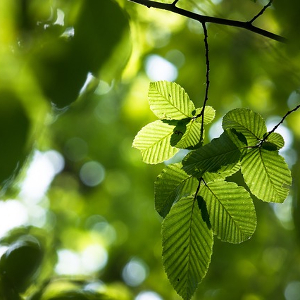 | Ježík, M; Blaženec, M; Kučera, J; Střelcová, K; Ditmarová, Ľ The response of intra-annual stem circumference increase of young European beech provenances to 2012-2014 weather variability Journal Article i-Forest, 9 (6), pp. 960-969, 2016, ISSN: 1971-7458. Abstract | Links | BibTeX @article{Ježík2016,
title = {The response of intra-annual stem circumference increase of young European beech provenances to 2012-2014 weather variability},
author = {M. Ježík and M. Blaženec and J. Kučera and K. Střelcová and Ľ. Ditmarová},
url = {http://www.sisef.it/iforest/contents/?id=ifor1829-009},
doi = {10.3832/ifor1829-009},
issn = {1971-7458},
year = {2016},
date = {2016-01-01},
journal = {i-Forest},
volume = {9},
number = {6},
pages = {960-969},
abstract = {The increasing frequency and severity of extreme weather events, especially droughts, arising from on-going climate changes negatively affect productivity and stability of forest ecosystems. Understanding species responses and suitable ecotypes that are able of adapting to new environmental conditions is increasingly important. The objective of this study was to quantify the relationships between the inter-annual stem circumference increase (SCI) of five European beech (Fagus sylvatica L.) provenances and weather variability during 2012-2014 in a provenance trial located in central Slovakia. SCIs were extracted on daily and weekly scale from hourly data of circumference changes. To detect the main environmental factors influencing SCI seasonal dynamics, intra-seasonal moving correlation functions were calculated. All five provenances responded synchronously to weather conditions, with high correlations among them during the growing season on both daily and weekly scale. The photoperiod exhibited a synchronizing effect on the seasonal peak of SCI as a sign of tree adaptation to long-term seasonal variations in climate. Temperature was the most significant factor influencing SCI dynamics at the beginning of the season. During the summer months, a precipitation deficit, heat waves and the consequently decreased soil water potential significantly affected the SCI of young beech trees, despite the fact that the provenance plot was situated in an area of optimum beech growth. Not only the severity and duration were important but also the timing of drought within a season. Within all seasons, the lowest SCI values were recorded for the provenance from the lowest altitude and the most oceanic climate (northern Germany). A comparison of daily and weekly SCI with first derivatives of growth functions indicated that SCIs were closely related to theoretical incremental processes, especially on a weekly scale. In young beech trees, SCI seemed to represent an appropriate proxy for studying intra-seasonal incremental processes. A newly designed SASB (self adjusting sharp beginning) function fit these processes better than the Gompertz function.},
keywords = {},
pubstate = {published},
tppubtype = {article}
}
The increasing frequency and severity of extreme weather events, especially droughts, arising from on-going climate changes negatively affect productivity and stability of forest ecosystems. Understanding species responses and suitable ecotypes that are able of adapting to new environmental conditions is increasingly important. The objective of this study was to quantify the relationships between the inter-annual stem circumference increase (SCI) of five European beech (Fagus sylvatica L.) provenances and weather variability during 2012-2014 in a provenance trial located in central Slovakia. SCIs were extracted on daily and weekly scale from hourly data of circumference changes. To detect the main environmental factors influencing SCI seasonal dynamics, intra-seasonal moving correlation functions were calculated. All five provenances responded synchronously to weather conditions, with high correlations among them during the growing season on both daily and weekly scale. The photoperiod exhibited a synchronizing effect on the seasonal peak of SCI as a sign of tree adaptation to long-term seasonal variations in climate. Temperature was the most significant factor influencing SCI dynamics at the beginning of the season. During the summer months, a precipitation deficit, heat waves and the consequently decreased soil water potential significantly affected the SCI of young beech trees, despite the fact that the provenance plot was situated in an area of optimum beech growth. Not only the severity and duration were important but also the timing of drought within a season. Within all seasons, the lowest SCI values were recorded for the provenance from the lowest altitude and the most oceanic climate (northern Germany). A comparison of daily and weekly SCI with first derivatives of growth functions indicated that SCIs were closely related to theoretical incremental processes, especially on a weekly scale. In young beech trees, SCI seemed to represent an appropriate proxy for studying intra-seasonal incremental processes. A newly designed SASB (self adjusting sharp beginning) function fit these processes better than the Gompertz function. |
2015
|
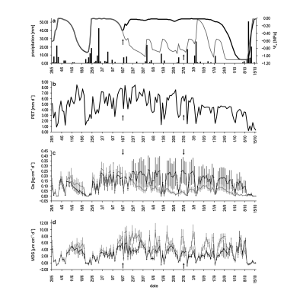 | Ježík, M; Blaženec, M; Letts, M G; Ditmarová, Ľ; Sitková, Z; Střelcová, K Assessing seasonal drought stress response in Norway spruce (Picea abies (L.) Karst.) by monitoring stem circumference and sap flow Journal Article Ecohydrology, 8 (3), pp. 378–386, 2015. Links | BibTeX @article{M.2015b,
title = {Assessing seasonal drought stress response in Norway spruce (\textit{Picea abies} (L.) Karst.) by monitoring stem circumference and sap flow},
author = {M. Ježík and M. Blaženec and M.G. Letts and Ľ. Ditmarová and Z. Sitková and K. Střelcová},
url = {http://onlinelibrary.wiley.com/doi/10.1002/eco.1536/full},
year = {2015},
date = {2015-04-01},
journal = {Ecohydrology},
volume = {8},
number = {3},
pages = {378–386},
keywords = {},
pubstate = {published},
tppubtype = {article}
}
|
2014
|
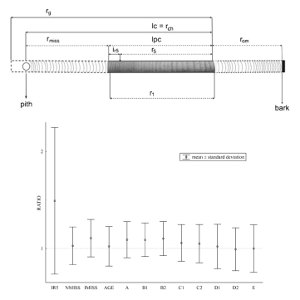 | Sedmák, R; Sedmáková, D; Bošeľa, M; Marušák, R; Ježík, M; Murga, V; Blaženec, M Age estimation of Norway spruce using incomplete increment cores: testing new and improved methods Journal Article Dendrochronologia, 32 (4), pp. 327–335, 2014. Links | BibTeX @article{R.2014b,
title = {Age estimation of Norway spruce using incomplete increment cores: testing new and improved methods},
author = {R. Sedmák and D. Sedmáková and M. Bošeľa and R. Marušák and M. Ježík and V. Murga and M. Blaženec},
url = {http://www.sciencedirect.com/science/article/pii/S1125786514000599},
year = {2014},
date = {2014-01-01},
journal = {Dendrochronologia},
volume = {32},
number = {4},
pages = {327–335},
keywords = {},
pubstate = {published},
tppubtype = {article}
}
|
2011
|
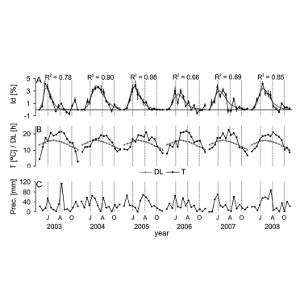 | Ježík, M; Blaženec, M; Střelcová, K; Ditmarová, Ľ The impact of the 2003-2008 weather variability on intra-annual stem diameter changes of beech trees at a submontane site in central Slovakia Journal Article Dendrochronologia, 29 , pp. 227-235, 2011. BibTeX @article{Ježík2011,
title = {The impact of the 2003-2008 weather variability on intra-annual stem diameter changes of beech trees at a submontane site in central Slovakia},
author = {M. Ježík and M. Blaženec and K. Střelcová and Ľ. Ditmarová},
year = {2011},
date = {2011-01-01},
journal = {Dendrochronologia},
volume = {29},
pages = {227-235},
keywords = {},
pubstate = {published},
tppubtype = {article}
}
|
2007
|
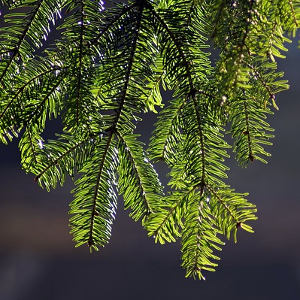 | Ditmarová, Ľ; Kmeť, J; Ježík, M; Váľka, J Mineral nutrition in relation to the Norway spruce forest decline in the region Horný Spiš (Northern Slovakia) Journal Article Journal of Forest Science, 53 (3), pp. 93-100, 2007. BibTeX @article{Ditmarová2007,
title = {Mineral nutrition in relation to the Norway spruce forest decline in the region Horný Spiš (Northern Slovakia)},
author = {Ľ. Ditmarová and J. Kmeť and M. Ježík and J. Váľka},
year = {2007},
date = {2007-01-01},
journal = {Journal of Forest Science},
volume = {53},
number = {3},
pages = {93-100},
keywords = {},
pubstate = {published},
tppubtype = {article}
}
|
